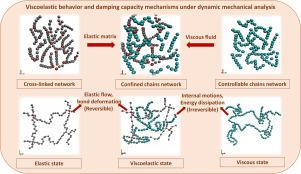当前位置:
X-MOL 学术
›
Comp. Mater. Sci.
›
论文详情
Our official English website, www.x-mol.net, welcomes your feedback! (Note: you will need to create a separate account there.)
Mechanical and viscoelastic characterization of Al2O3 based polymer nanocomposites: An experimental and molecular dynamics simulation approach
Computational Materials Science ( IF 3.3 ) Pub Date : 2024-03-27 , DOI: 10.1016/j.commatsci.2024.112955 Qurat Ul Ain , M.F. Wani , Rakesh Sehgal , Manjesh Kumar Singh
Computational Materials Science ( IF 3.3 ) Pub Date : 2024-03-27 , DOI: 10.1016/j.commatsci.2024.112955 Qurat Ul Ain , M.F. Wani , Rakesh Sehgal , Manjesh Kumar Singh

|
Polymer nanocomposites (PNCs) being revolutionary materials, comprises polymer matrix phase and nanoparticles (NPs) phase. This study focuses on incorporating alumina () into poly-dimethyl siloxane (PDMS) matrix to analyze viscoelastic behavior and damping in response to dynamic mechanical loading. The experiments were performed using nano-DMA for comparing how reinforcement influences structural conformations and dynamic properties of PNCs. At 100 Hz, the storage modulus () increases by 150%, 20%, and 74% for 1.0 wt% NPs with average particle sizes of 25 nm, 80 nm, and 200 nm, respectively. The significant changes in storage modulus and hardness values occur during variable frequencies (10 to 50 Hz) for 1.0 wt%, 9.0 wt%, and 7.0 wt% with reinforcements of 25 nm, 80 nm, and 200 nm, respectively. Adhesion factor and reinforcement efficiency factor highlight complementary effects of reinforcements at different frequencies. Further, an all-atom MD simulation method characterizes static and dynamic properties, predicting comprehensive dynamical and structural–property relationships. This quantifies damping capacity and reveals insights into how alters the material’s behavior. In summary, the study provides a precise comparative analysis of overall PNC performance, emphasizing the intrinsic effect on mechanical properties. It recognizes deformation mechanisms driving energy storage and dissipation for developing PNCs with enhanced mechanical performance.
中文翻译:

Al2O3 基聚合物纳米复合材料的机械和粘弹性表征:实验和分子动力学模拟方法
聚合物纳米复合材料(PNC)是革命性的材料,由聚合物基体相和纳米粒子(NPs)相组成。本研究重点是将氧化铝 () 纳入聚二甲基硅氧烷 (PDMS) 基质中,以分析响应动态机械载荷的粘弹性行为和阻尼。实验使用纳米 DMA 进行,比较增强材料如何影响 PNC 的结构构象和动态特性。在 100 Hz 时,平均粒径为 25 nm、80 nm 和 200 nm 的 1.0 wt% NP 的储能模量 () 分别增加 150%、20% 和 74%。对于 1.0 wt%、9.0 wt% 和 7.0 wt% 的增强体,分别采用 25 nm、80 nm 和 200 nm 的增强材料,储能模量和硬度值在不同频率(10 至 50 Hz)期间发生显着变化。粘附因子和增强效率因子突出了不同频率增强的互补效应。此外,全原子MD模拟方法表征了静态和动态特性,预测了全面的动态和结构-特性关系。这可以量化阻尼能力并揭示如何改变材料行为的见解。总之,该研究对 PNC 的整体性能进行了精确的比较分析,强调了对机械性能的内在影响。它认识到驱动能量存储和耗散的变形机制,以开发具有增强机械性能的 PNC。
更新日期:2024-03-27
中文翻译:

Al2O3 基聚合物纳米复合材料的机械和粘弹性表征:实验和分子动力学模拟方法
聚合物纳米复合材料(PNC)是革命性的材料,由聚合物基体相和纳米粒子(NPs)相组成。本研究重点是将氧化铝 () 纳入聚二甲基硅氧烷 (PDMS) 基质中,以分析响应动态机械载荷的粘弹性行为和阻尼。实验使用纳米 DMA 进行,比较增强材料如何影响 PNC 的结构构象和动态特性。在 100 Hz 时,平均粒径为 25 nm、80 nm 和 200 nm 的 1.0 wt% NP 的储能模量 () 分别增加 150%、20% 和 74%。对于 1.0 wt%、9.0 wt% 和 7.0 wt% 的增强体,分别采用 25 nm、80 nm 和 200 nm 的增强材料,储能模量和硬度值在不同频率(10 至 50 Hz)期间发生显着变化。粘附因子和增强效率因子突出了不同频率增强的互补效应。此外,全原子MD模拟方法表征了静态和动态特性,预测了全面的动态和结构-特性关系。这可以量化阻尼能力并揭示如何改变材料行为的见解。总之,该研究对 PNC 的整体性能进行了精确的比较分析,强调了对机械性能的内在影响。它认识到驱动能量存储和耗散的变形机制,以开发具有增强机械性能的 PNC。



























 京公网安备 11010802027423号
京公网安备 11010802027423号